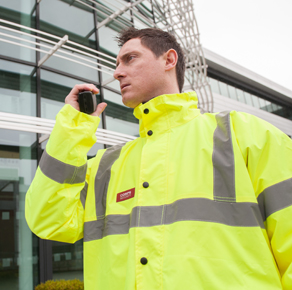A hybrid approach makes intelligent, integrated and truly seamless security possible, writes Peter Webster, Corps Security’s Chief Executive.
Despite widespread recognition of the need for people, property and assets to be protected in the most effective ways possible, there is still a marked division between the various sectors within the security industry. Although they work towards a common goal, manned guarding is often considered separately from electronic technology, and vice versa. Not only that; where the two are combined, they are mostly poorly integrated. What is needed is a truly hybrid approach that combines the best of both worlds in one seamless solution.
Car analogy
Consider the hybrid car, a recent but revolutionary arrival on our roads. These vehicles have two methods to power them – a petrol or diesel engine and an electric motor – but they work in perfect synchronisation to ensure reliable and energy efficient transport. Importantly, while the driver may select a specific power-train depending on requirements, the car itself can be left to ‘decide’ when to use its conventional engine or call upon its electric motor, based on algorithms that weigh inputs such as road conditions, anticipated journey length and required speed. I mention this analogy for two reasons. Firstly, compare the way that a hybrid car neatly combines two means of propulsion, with the fact that our industry still struggles to effectively combine electronic and physical security. A silo mentality means that manned guards are deployed at night when technology could provide the cover required, and explains why some sites rely on video surveillance when they would in fact be better served by physical guarding. As in the example of the hybrid car, electronic and physical security augment each other well and should be working in harmony.
Closer integration
At Corps Security, by configuring a security solution that combines manned guarding and technology, we have achieved cost reductions of up to 30 per cent without detriment to safety levels. For example, at the end of the working day electronic surveillance might take over from manned guards, or a site may employ guards in a gatehouse and rely on electronic surveillance in other areas such as warehousing. The bigger challenge is the closer integration of electronic and physical security to form a truly intelligent solution to a user’s security needs. Even on those sites where electronic and physical security are combined, they are often firmly demarcated, and the transition between the two is far from seamless. The shift from one system to another is often simply based around regimented working patterns, or tied to hours of operation. Yet threats don’t work on that basis, and can come at any time.
Reshaping
In the same way that the arrival of hybrid technology is changing the way we travel, emerging technologies are certain to radically reshape security as we know it. Looking to the not-so-distant future, I see a time when Artificial Intelligence (AI) removes the need for any pre-set human or electronic deployment, and ensures that a seamless transition between electronic and physical security can be made anywhere, anytime, based upon the prevailing circumstances. Just as a hybrid car can figure out the most appropriate source of power to use on its own, AI based technology would make the decision on the most appropriate deployment of security assets. This decision would be taken by a computer, based on its interpretation of human reporting and the data captured from a wide range of inputs including cameras, drone patrols, movement sensors, access control reporting, or building user requests. Having sifted through this wealth of information the hybrid security system of the future would deploy the ideal combination of security assets in real-time, based on the precise risk. And it would constantly monitor for environmental changes and new risks, and re-deploy assets as needed. The result would be an intelligent, integrated and truly seamless system.
Not quite there
Although this hybrid approach makes perfect sense in theory, the technology is not quite there yet. But be in no doubt: it is coming, and will be here soon. Indeed, instead of focusing on when the technology will arrive, our time would be better spent considering how we work together to deliver the efficiencies it will bring. The hybrid approach I outline here requires the various sectors of the security industry to join together in a spirit of collaborative working. While the technology will be here soon, it remains to be seen whether our industry is mature and forward-thinking enough to collaborate and embrace it.










